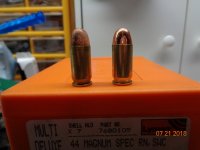Talk (including mine) is cheap. Buy some,test them,let us know what you find.So by some of the comments here someone please explain then why the hollow base bullets are rated to 1500fps or 250fps faster than a solid flat base if the hollow base is meant for a low pressure round?
You might get high velocity and low muzzle pressure from a 9mm carbine barrel 16 in long.
To keep from leading comps,the folksI know use Montana Gold bullets that are jacketed with no exposed lead at the base.
I gave it to my brother,but we have a Guncraft 38 Super single stack race gun built by Ben Jones in the 70's .It was owned by a champion shooter and has a high round count.
The ammo to run it is 40,000 psi 1400 + fps 38 Super,124 gr.For over 40 years
This gun is tight,slick,accurate,reliable. NOT beat up from those loads.
How?? The comp is efficient enough the gun runs on 9 to 12 pound recoil springs.That,and the Man who built it was a Master.
Last edited:



